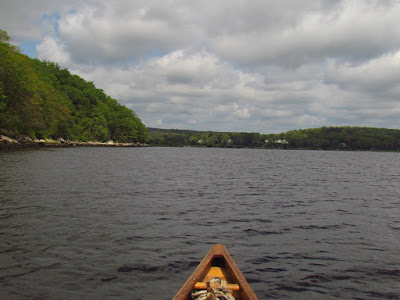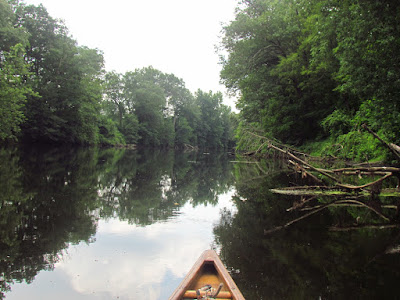I started late, left home late, enjoyed the morning sitting in the chair looking out the window. That's not particularly like me, but it happens. I headed toward the Great Swamp, but then had second thoughts. I went around the cloverleaf...the full tour of the cloverleaf and back to heading toward the Great Swamp. Curiosity won out. It is mid summer and the USGS gauge showed a reasonable amount of water, or at least what I think might be a reasonable amount of water. Too low and the trip is hellish - crawling over logs every couple hundred yards.
I started at the upper put in, the one that is down a long gravel road. R pulls in just as I am getting ready. We've talked several times before. He works for the parks dept. here in town. We chat for almost 40 minutes before I set out. Such things happen with canoes.
The water level is good. The river is narrow and down in its banks, but the water is cool and being fed steadily from the surrounding hills. There is a light current that keeps a center pathway open. But as expected, it is a constant turn to one side or the other, a tight meandering between bank or a protruding dead fall log. It is busy enough to keep it interesting without being difficult.
I come across a few log crossings. They are well spaced out so they don't feel a bother and the logs are flush with the water surface, so it is just a step out and balance while pulling the canoe over. I cross a couple easy beaver dams with no more trouble than that.
Unfortunately, this is wildlife siesta time. Animals like to move and feed in the morning, nap in midday, move more as dusk approaches. I spot a shy raccoon, two snapping turtles, one great blue heron, a few wood ducks, a few kingfishers, some frogs and a northern water snake. It's a low count, but that's what happens when you start late.
It seems a spiritual trip. I see no one and except at the halfway point, no one can access the river without hard exertions. I watch the water come past the bow of the canoe. I need to do this more often. I don't feel like breaking up my thoughts with writing....
nocturnal
2 days ago








































